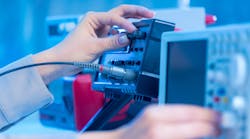Evaluate Power Device Efficiency with Double-Pulse Testing Using an AFG (.PDF Download)
Switching losses are inevitable in any power device. But these losses can be minimized through optimization and rigorous measurement of design parameters related to power efficiency. The preferred test method to measure the switching parameters of MOSFETs or IGBTs is the double-pulse-test method. By looking at turn-on, turn-off, and reverse-recovery parameters, engineers can thoroughly evaluate the dynamic behaviors of power devices under a range of conditions, whether to optimize devices or confirm the actual value or deviation of power devices and modules.
Performing this test requires generating at least two voltage pulses with varying pulse widths and precise timing, a historically time-consuming and error-prone process. However, this is changing with the advent of arbitrary function generators (AFGs) equipped with double-pulse-test application software. To get you down the road toward performing the double-pulse test more easily on your devices, we’ll first look at the basis for the double-pulse test. Then we’ll offer up tips and examples for efficiently performing double pulse testing using an AFG and an oscilloscope.
